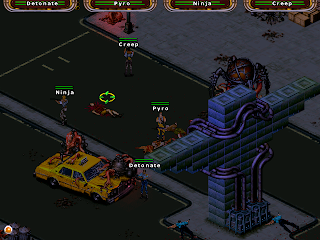I remember reading about Project Nomads when it first came out, and the concept of it made me very interested. The arcane steampunk setting seemed fantastic, the idea of the game impressed me, and it seemed like one of those crazy games that I just had to try. I picked it up a little while ago, and finally got around to playing it recently.
When Project Nomads gets it right, it gets it so damn right. At one point I found myself soaring through the air with just my jetpack, zooming towards the huge floating rock that was my enemy's base. Seeing some planes launch from within it, I dove down, flying underneath rock arches to avoid their fire, and then swooped back up, between a narrow gap in the walls of his stony fortress in the sky, placing explosives near two of his hangars and then launching back into the air as they exploded behind me. It was evocative, breathtaking and completely immersive.
Sadly, for 95% of the game, it's an exercise it tedious, akward frustration. The game starts out promisingly enough; full of all sorts of exciting opportunities. It's hard to describe the range of genres that the game incorporates, but there's base building, repair and management, on rails turrent based shooting, action adventure style exploration running around with magic based combat, combat flight simulation dogfights... it really throws a whole bunch of stuff into the mix and surprisingly enough none of it stands out as being *overly* bad. There's definitely weak points - in the sections where you're on foot especially - but for the most part it passes.
The parts that are issues - the button for shooting being different from one section to another, the fact that your character walks so incredibly slowly backwards, the terribly annoying amount of times you'll fall over for no decent reason - are so small and slight that they could have been tweaked so incredibly easily, which is why it's such a shame that they weren't. I have no doubt that testers would have flagged these things as issues, and it's very disappointing that they're still in the game.
The big issue, though, and the thing that holds Project Nomads back from being anything more than a frustrating glimpse at what could otherwise have been a great game, is the level design. The first level where you're sent off on your own once learning the basics consists of creeping your base forward a bit, stopping, shooting everything, repeat for about an hour. It's mind numbingly tedious. This would have been a fun section for 10-15 minutes, but beyond that it loses the intensity and drags.
Following this, you then find yourself running around and if you explore enough can find the beautiful, magical jetpack, which somehow makes all that tedium worthwhile... until several minutes later when you're thrown into another part almost as tedious as before. What it feels like is padding, and the most boring sort of padding you can imagine. Imagine Full Throttle, except with 10 sections where you need to ride your motorcycle around and 10 demolition derbies. That's a little like how Project Nomads feels to me. Rather than playing its strengths, it relies far too much on getting by on the same idea repeated over and over.
Presentation wise, this is a mixed bag. The graphics, while definitely showing their age, are unique, evocative and much prettier than other games of the same vintage. For a ten year old game, it's still quite pretty and the art design especially is quite inspiring... minus the strange spirit you meet at the start who simply looks like a children's tv show wizard. You can pick your character depending on how you like to play; you have a big hulking robot, a small, nimble lady and, quite naturally, the fellow in between, who was an obvious choice simply due to the simply marvellous mustache he sports. The environment is very unique, totally free of the generic action game settings that get overused and very bold with it's willingness to be different.
The sound is laughable at best. The music is some of the least consistent stuff I've come across in a game, the sound effects can be confusing, with my giant cannon going from enthusiastic booms one minute to strange clicks the next, and the voice acting is absolutely atrocious.
It's sad, then, to see a title holding such an amazing amount of promise fall so completely short of the mark simply because of these strange decisions. Perhaps they were trying to rush the game out, so they didn't have time to fix all the strange glitches? Maybe they had a publisher telling them the game had to run for X amount of hours and so they were forced to pad out each section to make it run for the required amount of time. I think if the game had cut all this tedious rubbish and just been a few hours long, it'd be a very fondly remembered game which is criticized for being too short - much like Beyond Good and Evil. Instead, it's forgotten and unloved, a victim of being bloated and underpolished. For the 5% of the game when you're soaring through the skies, weaving between, through and beneath the huge floating rocks and dodging enemy fire from all directions, Project Nomads is absolutely breathtaking, and beautifully memorable. For the rest of the time, it's utterly forgettable.

















